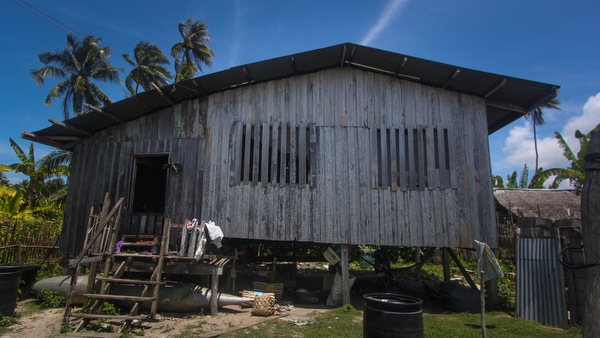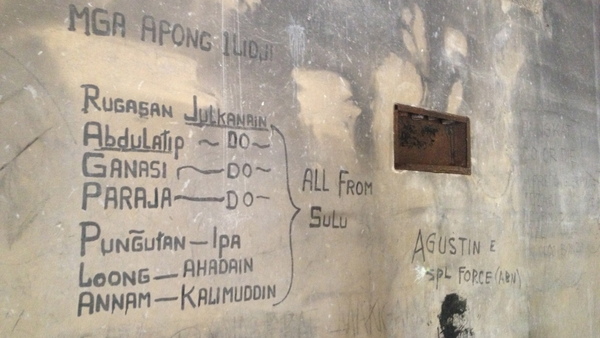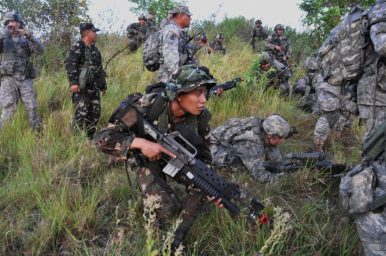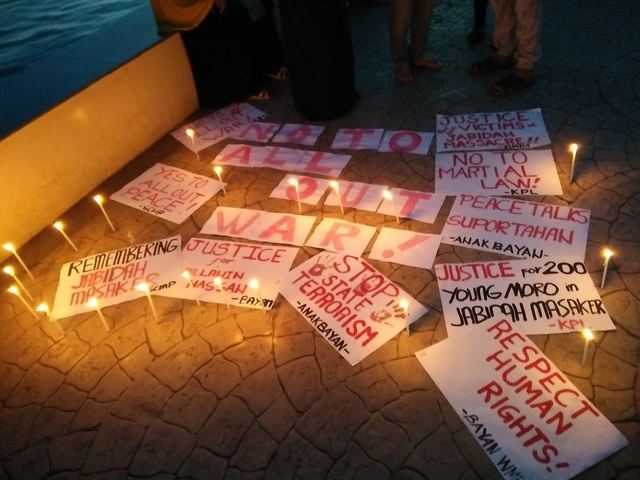Posted to Rappler (Mar 18, 2013):
Jabidah and Merdeka: The inside story
The officers who participated in the Jabidah massacre have not fully come clean. In the end, it may have left a legacy of lying and cover-up in the military.

(
Editor's note: On March 18, 1968 – exactly 45 years ago today – at least 23 Muslim trainees were shot to death on Corregidor Island in what has since been known as the Jabidah massacre. Below is a summary of "In the name of honor?," the chapter on the Philippine government's clandestine operation to invade Sabah written by Marites Dañguilan Vitug and Glenda M. Gloria in their book "Under the Crescent Moon: Rebellion in Mindanao," which was first published in 2000.)
As it was a special government operation, details of Oplan Merdeka were known only to a few people. But the general concept was explained to the officers who were involved in it. The Philippines was to train a special commando unit – named Jabidah – that would create havoc in Sabah. The situation would force the Philippine government to either take full control of the island or the residents would by themselves decide to secede from Malaysia. Many Filipinos from Sulu, Tawi-Tawi, and parts of Mindanao had migrated to Sabah. Oplan Merdeka was banking on this large community to turn the tide in favor of secession.
About 17 men, mostly recruits from Sulu and Tawi-Tawi, entered Sabah as forest rangers, mailmen, police. The Filipino agents blended into Sabah's communities. Their main task was to use psychological warfare to indoctrinate and convince the large number of Filipinos residing in Sabah to secede from Malaysia and be part of the Philippines. Part of their job was to organize communities which would support secession and be their allies when the invasion took place. They also needed to reconnoiter the area and study possible landing points for airplanes and docking sites for boats.
The project did not exactly start from ground zero. Even before then Army Maj Eduardo Martelino sent his men to Sabah, Philippine armed forces intelligence was already eavesdropping on the island. In the early 1960s, there was concern over the possibility that a Pan-Islamic movement financed by Libya's Muammar Qadaffi would reach the southern Philippines.
Martelino himself went to Sabah 3 times on secret missions as head of the Jabidah forces, he would reveal in a newspaper interview on Aug 1, 1968. The landing points he used were Tambisan Point, Lahad Datu, and Semporna. Some of his men traveled on one of the 50 or more fast-moving fishing boats owned by big-time smuggler Lino Bocalan. They frequently travelled from Cavite to Sabah, where they loaded thousands of cases of "blue-seal" cigarettes. At that time, imported cigarettes were not allowed into the Philippines.
Bocalan, only 31 then, was already a millionaire. In his coastal home in Cavite in 1998, Bocalan admitted: "Marcos told me he needed help for Sabah. My duty was to finance the operation. I spent millions (of pesos)… I fed the Filipino trainees in Sabah, paid their salaries. I sent my brother and my people to Tawi-Tawi and Corregidor to give food and money (to the recruits.)."
Malaysia seemed an easy and vulnerable target at that time. The Federation was still new and fragile, having come into being only in 1963. Ferdinand Marcos cast his covetous eyes on a country that was still on its way to political cohesion.
On the ground, though, trade relations between Mindanao and Sabah picked up. Traders made regular clandestine visits and their business was classified as "smuggling." Feeling the need to reduce smuggling in that zone, the government looked for a special operations officer to map out an anti-smuggling campaign plan.
Thus, all 3 factors converged and became the context as well as backdrop for Oplan Merdeka: the fear of a Pan-Islamic movement creeping into Mindanao, a vulnerable Federation of Malaysia, and an anti-smuggling operation.
 FAILED DREAMS. This is where a Jabidah recruit, Ernesto Sambas, continues to live in Simunul, Tawi-Tawi. Photo by Karlos ManlupigSimunul training
FAILED DREAMS. This is where a Jabidah recruit, Ernesto Sambas, continues to live in Simunul, Tawi-Tawi. Photo by Karlos ManlupigSimunul training The training of recruits from Sulu and Tawi-Tawi was done in Simunul, a picturesque island-town of Tawi-Tawi (
Read: Jabidah recruits plotted Sabah standoff). From August to December 1967, Martelino, assisted by then Lt Eduardo Batalla, set up camp and trained close to 200 men – Tausugs and Sama (the dominant ethnic tribe in Tawi-Tawi) aged 18 to about 30. A number of them had had experience in smuggling and sailing the kumpit, a wooden boat commonly used in the area. What enticed the young men to Martelino's escapade was the promise of being part of an elite unit in the Armed Forces. It was not just an ordinary job. It gave them legitimate reason to carry guns – carbines and Thompson submachine guns. It gave them a sense of power.
Camp Sophia, named after Martelino's second wife, a young, naive, and pretty Muslim, was inside a coconut plantation, fenced by barbed wire. A hut housed a powerful transceiver and served as a radio room. Bunks were made of ipil-ipil and makeshift twigs. A watchtower stood tall in the perimeter, facing the sea. It was a world of their own making, with the trainees wearing distinct badges showing crossbones and a black skull with a drip of blood on the forehead. Their rings were engraved with skull and crossbones.
Today, no trace remains of a military camp in Simunul, not a single marker. What was once Camp Sophia now looks deserted, planted to palm and coconut trees with wild grass.
Bound for CorregidorOn Dec 30, 1967, anywhere from 135 (the late Sen Ninoy Aquino's count) to 180 (former Capt Cirilo Oropesa's count) recruits boarded a Philippine Navy vessel in Simunul bound for Corregidor, a tadpole-shaped island guarding the mouth of Manila Bay. For two days and one night, the troops sailed from the southernmost tip of the Philippines to Corregidor. They spent the New Year at sea and reached the island off Cavite on Jan 3, 1968.
Corregidor was the last bastion of Filipino-American resistance against invading Japanese forces. It was the site of many deaths and some describe its history as written in blood. Today, it is a tourist destination, with the ruins of battle well preserved.
However, Jabidah is never mentioned as part of Corregidor's storied past. The hospital turned military barracks and the airstrip where the killings took place are not included in the routine tour. But graffiti of trainees' and trainers' names, places ("all from Sulu," "Siasi market site," "Tapul, Sulu") and one memorable date – "Jan. 3/68," when they arrived in Corregidor – bear witness to Corregidor's connection to another island.
Before the recruits docked in Corregidor, the old Corregidor hospital was cordoned off and declared a restricted area. It was to be the military barracks. The trainees were to stay inside the bombed-out hospital on the topside of the island, the highest point on Corregidor, surrounded by trees and bushes.
Once on the island, the trainees were ordered to cut the trees surrounding the camp. They were taught to dig foxholes and use parachutes. They kept a rigid schedule, and were up at 5 o'clock in the morning for a two-hour jog followed by drills. Lectures took place in the afternoons.
Ernesto Sambas, a recruit from Tawi-Tawi, recalls seeing many other soldiers on Corregidor, but their batch from Simunul was confined to one area on the island. It appears that there was discrimination against the Tausug trainees. Sambas said he got his pay but those from Sulu did not. As a commissioned officer, Sambas also noticed the growing restlessness among other Muslim youths. The recruits were getting impatient because they couldn't send a single centavo back home. Their promised pay of P50 a month was never given. The officers were aware of the agitation among the recruits. They knew that it was just a matter of time before mutiny erupted.
As a precautionary measure, then Lt Rolando Abadilla and the rest took shifts guarding their own barracks at night. Sambas remembers that they sent at least 16 of the Muslims back to Sulu because they were always complaining.
By the fourth week of February 1968, some of the trainees started to get restless. Since their arrival in Corregidor, they had not been paid a single centavo. Their food was miserable. They slept on ipil wood and cots. Meanwhile, their officers pampered themselves in comfortable, air-conditioned rooms at the Bayview Hotel, across the Manila Bay, a short boat trip from Corregidor.
 REMEMBRANCE. Graffiti that reminds tourists of the gruesome killings in 1968. Photo by Angela CasauaySent packing
REMEMBRANCE. Graffiti that reminds tourists of the gruesome killings in 1968. Photo by Angela CasauaySent packingThe trainees decided to complain and secretly wrote a petition addressed to President Marcos, signed by about 62 trainees. Others placed their thumb marks. They wanted their pay plus an improvement in their living conditions. Martelino visited the trainees and assured them of their pay. He later met with the 4 leaders of the petitioning group. To this day, 3 of them remain unaccounted for.
After this, the trainees were given fiesta food: goat, beef, and Nescafe coffee with milk. Almost every night there was music and dancing. But with the good food and entertainment came the bad news: the rest of the signatories of the petition were disarmed. Effective March 1, 1968, all 58 of them were considered resigned.
Some 60 to 70 trainees, meanwhile, were transferred to Camp Capinpin in Rizal. On March 16, another batch was taken away from Corregidor. These 24 men boarded the same boat that had brought them to Corregidor in the New year. Then Sen Ninoy Aquino, who led a Senate probe on the issue, later met this batch in Jolo when he did his own sleuthing in March.
On March 18, another 12 recruits were told to prepare for home. At 2 am, they left camp. These men, till today, are unaccounted for. Soon after, on the same day, another batch of 12 was told that they were going to leave at 4 am. Why a dozen per batch? Because the plane, they were told, could carry only 12 passengers. Jibin Arula, the most famous of the Jabidah survivors, belonged to this second batch.
Arula's memory of this day remains vivid: "We went to the airport on a weapons carrier truck, accompanied by 13 (non-Muslim) trainees armed with M-16 and carbines. When we reached the airport, our escorts alighted ahead of us. Then Lt Eduardo Nepomuceno ordered us to get down from the truck and line up [Nepomuceno was later killed in Corregidor under mysterious circumstances]. As we put down our bags, I heard a series of shots. Like dominoes, my colleagues fell. I got scared. I ran and was shot at, in my left thigh. I didn't know that I was running towards a mountain….By 8 am, I was rescued by two fishermen on Caballo Island, near Cavite."
A presidential helicopter swooped down on Corregidor shortly after the killings. Officers and men belonging to the Army Special Forces leaped out of the aircraft and engaged in a clandestine cover-up mission to erase traces of the massacre.
When they landed, the teams of soldiers found burned bodies tied to trees, near the airstrip, on the island's bottom side. The order from Army chief Gen Romeo Espino was to clean up the place and clear it of all debris. From afternoon till sunset, they collected charred flesh and bones and wrapped them in dark colored ponchos. They could not keep track of how many bodies there were. They also picked up bullet shells lying on the airstrip. The trainees had been shot dead before they were tied and burned.
At the crack of dawn the next day, they loaded the ponchos in the helicopter and flew over Manila Bay. They tied heavy stones to the ponchos before dumping them all into the sea. The remains sank, weighed down by the stones. The soldiers made sure nothing floated to the surface.
Major players diedIf Marcos and his men were to be believed, the killings on Corregidor never happened. The expose on Jabidah, they said, was part of a grand plot by the opposition to discredit the Marcos regime. They said Arula, a survivor of the massacre, was an agent planted by Malaysia after it had uncovered Jabidah's purpose.
The Armed Forces top brass never ordered a search for missing persons, living and dead. No real investigation took place, except for a few Senate and Congressional hearings which yielded inconclusive findings. The young and intensely energetic opposition Sen Ninoy Aquino Jr, using his deft journalistic skills, put some of the pieces of the Jabidah puzzle together, but the picture remained incomplete.
Eight officers and 16 enlisted men were court-martialed in 1968. All of them, however, were cleared in 1971. The major actors are by now all dead.
After Jabidah, Abadilla gained notoriety as head of the Military Intelligence Security Group that arrested and killed political activists. In 1996, communist guerrillas shot him dead while his car was held by traffic at a busy intersection along Katipunan Avenue in Quezon City.
Abadilla's immediate commander in Oplan Merdeka, Eduardo Battalla, had been killed much earlier, in 1989, when he bungled a hostage incident involving a bandit, Rizal Alih. Batalla, then a general, was the regional Constabulary commander in Western Mindanao. (Editor's note: We earlier said Battala was commander of the military's Southern Command then. We regret the error.)
Martelino, who executed Merdeka, was reported to have been imprisoned in Sabah in 1973. Martelino returned to Sabah after his acquittal, his daughter Pat Martelino Lon recalls. They believe he is dead, but a few of his former colleagues think he may still be languishing in a Malaysian prison.
Some senior military officers and men talked to us in 1997 and 1998 to fill in the gaps of this story. A number of them participated in the operation as leaders who gave orders or followers who implemented such orders. Others knew or were close to the people who were recruited to Jabidah.
For many soldiers involved in Operation Merdeka, there was nothing wrong with a plot to take back a territory they believe the Philippines owned. Looking back, they say that if not for the bungled training, the killings would not have ensued and Oplan Merdeka would have pushed through.
But the Jabidah massacre tainted the reputation of the military. Those who participated, either in actual training or in the clean-up operations, have not fully come clean. In the end, it may have left a legacy of lying and cover-up.
http://www.rappler.com/newsbreak/24025-jabidah-massacre-merdeka-sabah


















